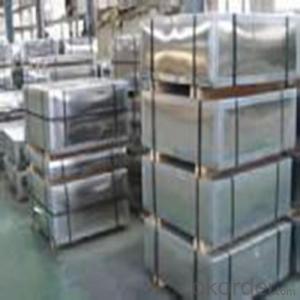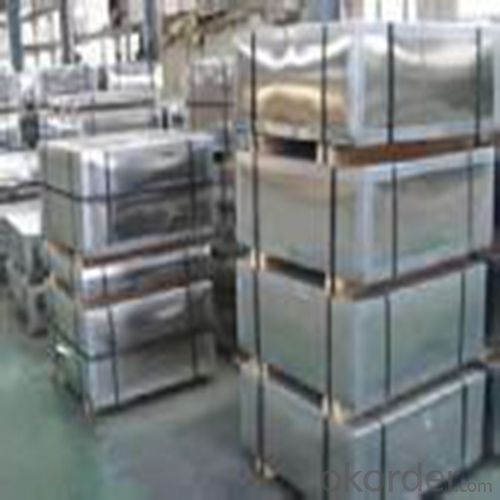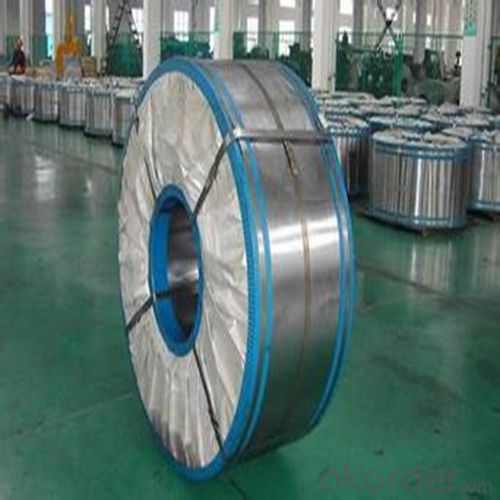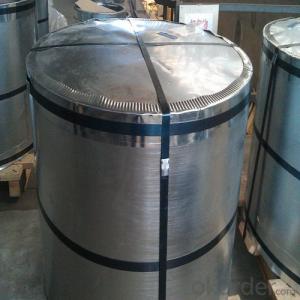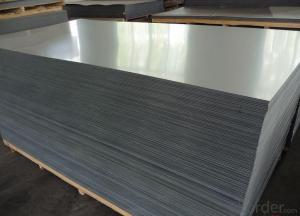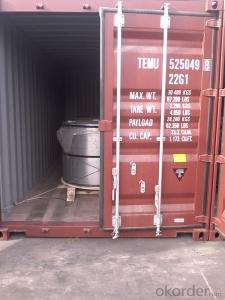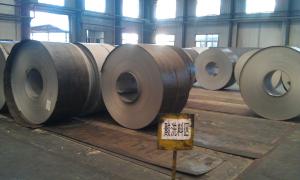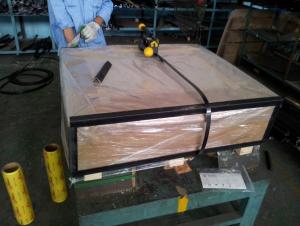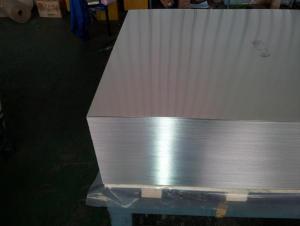Electrolytic Tinplate for Chemical Industrial Can Use
- Loading Port:
- Qingdao
- Payment Terms:
- TT OR LC
- Min Order Qty:
- 50 m.t.
- Supply Capability:
- 30000 m.t./month
OKorder Service Pledge
OKorder Financial Service
You Might Also Like
1.Structure of ElectrolyticTinplate for Chemical Industrial Can Use Description
Electrolytic Tinplate, is one thin steel sheet with a coating of tin applied by electrolytic deposition. Tinplate made by this process is essentially a sandwich in which the central core is strip steel. This core is cleaned in a pickling solution and then fed through tanks containing electrolyte, where tin is deposited on both sides. As the strip passes between high-frequency electric induction coils, it is heated so that the tin coating melts and flows to form a lustrous coat.
2.Main Features of the ElectrolyticTinplate for Chemical Industrial Can Use
The salient feature of DR Tinplate is the combination of higher strength and sufficient ductility, which enables much thinner Tinplate to be used, compared to Single Reduced Tinplate resulting in Substantial economic savings.
According to the steel chemistry and annealing process, the second reduction (DR08) can be between 27% to 40%, thereby producing strengths upto 550 +/-50 N/mm2, whereas single reduced material has strength less than 450 N/mm2 &DR 09 (Hard DR) is produced at temper mill with reduction % in range of 27-35 % & will strength upto 690 N/mm2 to the produced material.
3. ElectrolyticTinplate for Chemical Industrial Can Use Images

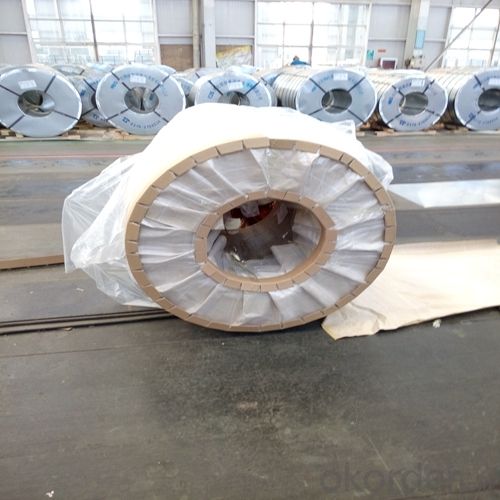
4.ElectrolyticTinplate for Chemical Industrial Can Use Specification
Standard: ISO 11949 -1995
Material: MR
Thickness:0.34mm
Width: 600mm
Temper: T3
Annealing: BA
Coil Inner Diameter: 508mm
Weight: 6-10 tons/coil 1~1.7 tons/sheets bundle
Passivation:311
Oil: DOS
Surface: Finish
5.FAQ of ElectrolyticTinplate for Chemical Industrial Can Use
- How are the tinplates specified?
The tinplates are specified as per the steel base, extent of tempering, the coating weight, annealing method and the surface finish.
- How many types there are for base steels?
The base steels are of three types: Type MR, L, D
- Q: What are the common applications of tinplate?
- Tinplate is commonly used in the packaging industry for products such as food and beverages, as well as for aerosol cans, paint cans, and metal closures. It is also used in the manufacturing of electrical components, automotive parts, and various household items.
- Q: What's the latest price for tinplate?
- It's about 7000 yuan. This tea is good.
- Q: What are the different ways to open tinplate cans?
- There are several ways to open tinplate cans, including using a can opener, a knife, a spoon, or even your hands if the can has a pull tab.
- Q: How is tinplate coated with organic coatings?
- Tinplate is coated with organic coatings through a process known as coil coating. In this process, the tinplate is cleaned and pre-treated to ensure proper adhesion of the organic coating. The organic coating, usually a resin-based material, is then applied to the tinplate in a continuous and uniform manner. The coated tinplate is then cured, either through heat or UV radiation, to ensure the coating adheres firmly to the surface. This coating provides protection against corrosion and enhances the appearance of the tinplate.
- Q: How does tinplate impact the overall product design?
- Tinplate impacts the overall product design by providing a durable and corrosion-resistant material that can be easily formed into various shapes. Its versatility allows for intricate designs and details, making it suitable for packaging, containers, and canning. Additionally, tinplate's smooth surface allows for vibrant printing, enhancing the visual appeal of the product. Overall, tinplate plays a crucial role in ensuring the functionality, aesthetics, and longevity of the product design.
- Q: What are the main applications of tinplate in the music industry?
- Tinplate is primarily used in the music industry for producing high-quality metal packaging for CDs, DVDs, and vinyl records. Its excellent durability and resistance to corrosion make it an ideal material for protecting and preserving music media. Additionally, tinplate is also used in the manufacturing of musical instrument components, such as guitar picks and drum shells, due to its malleability and acoustic properties.
- Q: Can tinplate packaging be used for frozen or refrigerated goods?
- Yes, tinplate packaging can be used for frozen or refrigerated goods. Tinplate is a durable and corrosion-resistant material that can withstand low temperatures without compromising the quality and safety of the packaged items. It provides a protective barrier against moisture, light, and oxygen, ensuring the preservation of frozen or refrigerated goods.
- Q: How does tinplate maintain its shape during the manufacturing process?
- Tinplate maintains its shape during the manufacturing process due to its inherent strength and rigidity, which is achieved through a combination of factors. Firstly, the steel substrate used in tinplate is typically made from low-carbon steel, which provides a sturdy foundation. Additionally, the tin coating on the steel provides an added layer of protection and stability. The tin layer acts as a barrier against corrosion and helps to prevent deformation or warping of the tinplate. Moreover, the manufacturing process involves carefully controlling the temperature and pressure, ensuring that the tinplate retains its shape and structural integrity.
- Q: What are the main challenges in the recycling of tinplate?
- One of the main challenges in the recycling of tinplate is the separation of tin from the steel. Tin is a valuable material and it is important to recover as much of it as possible during the recycling process. However, separating tin from steel can be a complex and energy-intensive process. Additionally, contaminants such as paints, coatings, and other metals need to be removed before the tinplate can be recycled, which adds to the difficulty of the recycling process. Another challenge is the collection and sorting of tinplate waste, as it often ends up mixed with other materials in municipal waste streams. This makes it necessary to implement effective collection and sorting systems to ensure that tinplate is properly recycled.
- Q: How is tinplate corrosion resistant?
- Tinplate is corrosion resistant due to the thin layer of tin coating that is applied to the surface of the steel. This tin layer acts as a barrier, preventing oxygen and moisture from coming into direct contact with the steel, which helps to inhibit the formation of rust and corrosion.
Send your message to us
Electrolytic Tinplate for Chemical Industrial Can Use
- Loading Port:
- Qingdao
- Payment Terms:
- TT OR LC
- Min Order Qty:
- 50 m.t.
- Supply Capability:
- 30000 m.t./month
OKorder Service Pledge
OKorder Financial Service
Similar products
Hot products
Hot Searches
Related keywords
